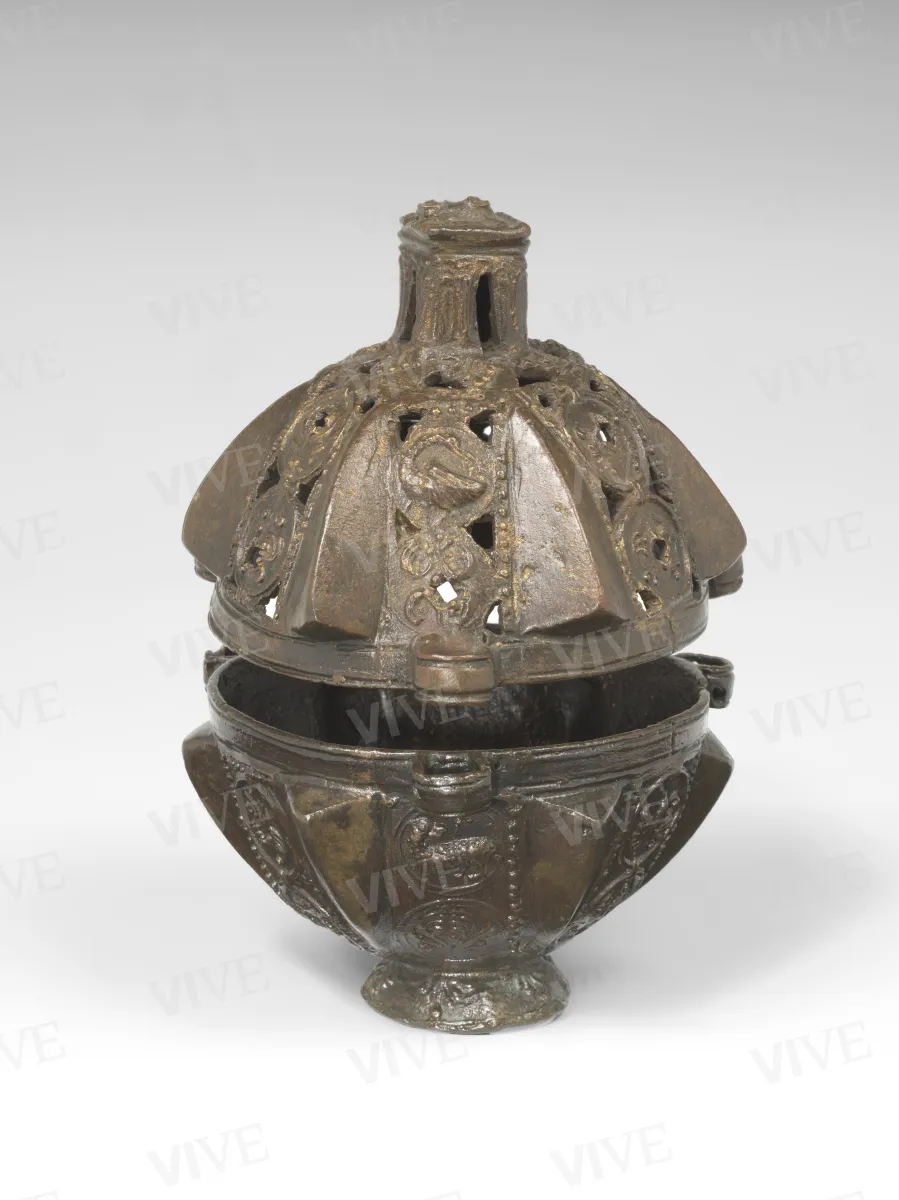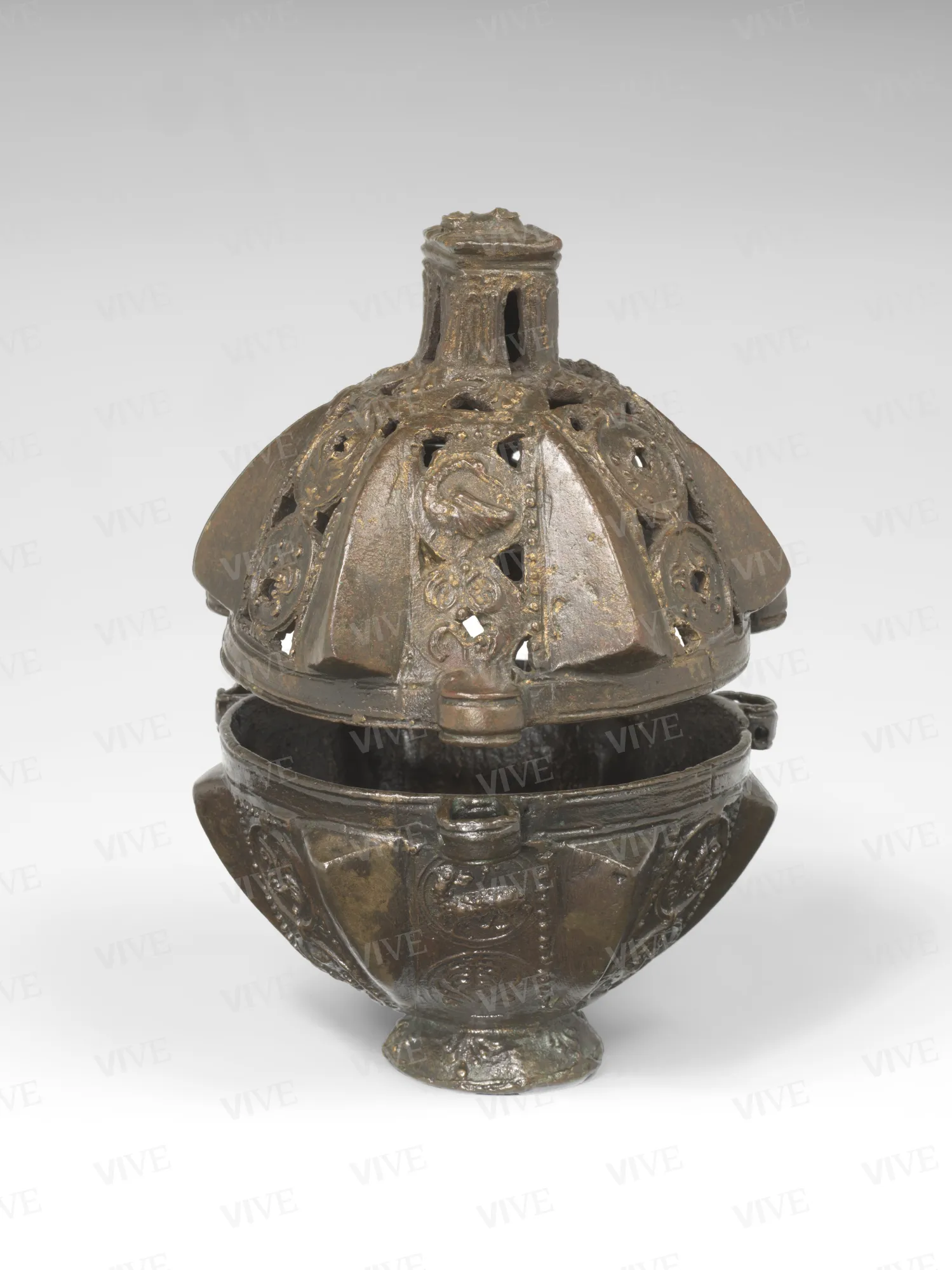Thurible
Northern Italian production Late-12th–early-13th century
Spherical in shape, this thurible rests on a truncated-conical base. The outer surface of both covers have an identical decorative format consisting of six protruding triangular projections alternating with rectangular forms. These rectangles, with beaded edges, are traversed by clypei containing palmettes, the Agnus Dei, and pairs of facing birds. Only in the upper canopy, surmounted by an arched lantern, are the spaces around these clypei worked openly. Chains once attached to the three surviving hooks are no longer extant.
Spherical in shape, this thurible rests on a truncated-conical base. The outer surface of both covers have an identical decorative format consisting of six protruding triangular projections alternating with rectangular forms. These rectangles, with beaded edges, are traversed by clypei containing palmettes, the Agnus Dei, and pairs of facing birds. Only in the upper canopy, surmounted by an arched lantern, are the spaces around these clypei worked openly. Chains once attached to the three surviving hooks are no longer extant.
Details of work
Catalog entry
Cited by Frederick Hermanin as an eleventh-century Byzantine work (1948, p. 298), this thurible is part of a coherent group of artifacts that has been the focus of decisive work on dating and geographical location in recent decades. Despite renewed interest in the subject, however, the Palazzo Venezia artifact has remained unknown and does not appear in Hiltrud Westermann-Angerhausen’s 2014 corpus of Romanesque bronze thuribles. Indeed, this repertory can be considered the most relevant contribution to the study of these materials, and to it we owe a rigorous periodization and classification into workshops of the type considered. What is presented here falls within a set characterized by the alternation of triangular protrusions and bands with ornamental motifs or depictions of standing saints. The taste for alternating vertical panes with phytomorphic ornamental motifs and panes with depictions of saints has been traced to the Byzantine area where this ornamental scheme is seen in the context of goldsmith production and in toreutics. Westermann-Angerhausen referred to the reliquary of Saint Demetrius in the Moscow Kremlin, a Byzantine work from the mid-eleventh century where representations of saints are interspersed with vertical spaces with palmettes (Westermann-Angerhausen 2014, p. 194). The workshops responsible for casting the thuribles belonging to this set have been located in north–central Italy with a date spanning the twelfth and thirteenth centuries (Hueck 1982, p. 182, no. 11.5; Del Grosso 2012, pp. 29–32). Indeed, the ornamental motifs found on these artifacts are well established in central–northern Italian artistic production. Palmettes, for example, appear in textiles but also Romanesque and early Gothic goldsmith production, while birds within clypei, alone or in pairs, derive from similar subjects in Venetian paterae (Westermann-Angerhausen 2014, pp. 129–133). Indeed, the permanence of such ornamental elements in various contexts of Italian artistic production, as well as the provenance from the central and northern regions shared by almost all the surviving pieces belonging to this set, implies that the hypothesis of Italian manufacture is still the most probable one. Workshops active in the casting of small bronzes could be found both in northern Italy—where this area of artistic production was very successful in the Romanesque period—and in central Italy, in a space that has been identified as between Tuscany and the Apennine belt (Del Grosso 2012, pp. 29–32). The workshop that worked on the production of thuribles of this type, however, had to operate on a large scale, producing specimens with homogeneous characteristics through a very repetitive production process that involved separately cast parts, such as the baccellature (pod-like structure) or apical lanterns, then fixed to the bronze caps. The most convincing comparisons for the Roman thurible can be established with specimens in the Museo Nazionale del Bargello in Florence (Westermann-Angerhausen 2014, p. 199, n. II or 17), with one from a private collection (Westermann-Angerhausen 2014, p. 199, no. II or 19), and one from the Schnütgen Museum in Cologne, which, among other things, bears a clypeus with an identical bird motif in profile (Westermann-Angerhausen 2014, p. 200, no. II or 24). A thurible from the Hermitage Museum in Saint Petersburg, in addition to being similar in its surface and the ornamental motifs, replicates quite accurately the square lantern present in the upper part of the Palazzo Venezia artifact (Westermann-Angerhausen 2014, p. 202, n. II or 32). All of these can be dated to between the end of the twelfth century and the beginning of the thirteenth: this time frame, therefore, also fits the Palazzo Venezia specimen perfectly in the context of a workshop active in north–central Italy.
Giampaolo Distefano
Entry published on 12 February 2025
State of conservation
Good.
References
Hermanin Federico, Il Palazzo di Venezia, Roma 1948;
Hueck Irene, L’oreficeria in Umbria dalla seconda metà del secolo XII alla fine del secolo XIII, in Pirovano Carlo, Porzio Francesco, Selvafiorita Ornella (a cura di), Francesco d’Assisi. Storia e arte, III, catalogo della mostra (Assisi, Sacro Convento, luglio-novembre 1982), Milano 1982, pp. 168-187;
Del Grosso Andrea, Chi ama brucia: turiboli toscani del Medioevo, Pisa 2012;
Westermann-Angerhausen Hiltrud, Mittelalterliche Weihrauchfässer von 800 bis 1500, Petersberg 2014.












